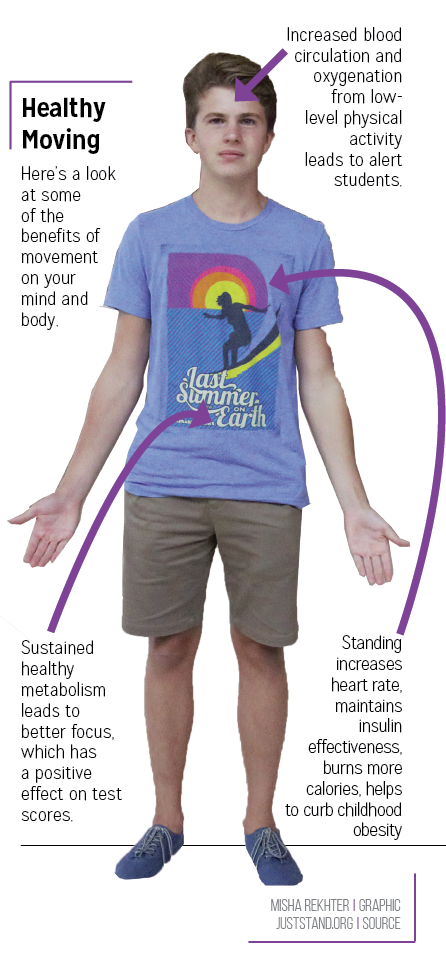 As the new school year is in full swing, teachers and students are hard at work. While most students keep up with a moderately active lifestyle during the summer months, transitioning back into a school regime after summer break may take some adjusting. Sitting still for 90 minutes, four times a day may not be everyone’s bread and butter, but in many traditional classroom settings, students tend to sit for a full period as teachers walk around and lecture about new material. This may not seem like an overwhelmingly difficult task for students, but upon closer inspection it takes a bigger toll than you think.
As the new school year is in full swing, teachers and students are hard at work. While most students keep up with a moderately active lifestyle during the summer months, transitioning back into a school regime after summer break may take some adjusting. Sitting still for 90 minutes, four times a day may not be everyone’s bread and butter, but in many traditional classroom settings, students tend to sit for a full period as teachers walk around and lecture about new material. This may not seem like an overwhelmingly difficult task for students, but upon closer inspection it takes a bigger toll than you think.
A 2013 report from the Institute of Medicine, a nonprofit branch of the National Academy of Medicine, concluded that children who are more physically active “show greater attention, have faster cognitive processing speed and perform better on standardized academic tests than children who are less active.” Implementing more interactive classroom activities would not only be beneficial to students’ overall mental fitness, morale and focus, but would reflect more positive results in student’s academic success.
Strategies to incorporate more mobility for sedentary activities are a must in keeping both student’s mental and physical aspects in top shape. Investing in standing desks, encouraging-out-of seat station work, or even incorporating regular mental breaks with physical movement would conquer any mental block during work time that is associated with cognitive processing.
Mental and physical function go hand-in-hand when working together to perform everyday tasks to the fullest ability. Physical fitness plays an equal part as a student’s mental state in academic success. JustStand.org, a research-based organization offering education of the the negative impact of excess sedentary activities, suggests that active learning styles can help reduce childhood obesity: Standing provides clear health benefits as it increases heart rate, maintains insulin effectiveness and burns more calories. Taking these factors into consideration, establishing a more active classroom environment will not only help stimulate students in their intellectual growth and produce better test scores, but teachers will receive more attention in the classroom setting.

































![AI in films like "The Brutalist" is convenient, but shouldn’t take priority [opinion]](https://hilite.org/wp-content/uploads/2025/02/catherine-cover-1200x471.jpg)










































![Review: “The Immortal Soul Salvage Yard:” A criminally underrated poetry collection [MUSE]](https://hilite.org/wp-content/uploads/2025/03/71cju6TvqmL._AC_UF10001000_QL80_.jpg)
![Review: "Dog Man" is Unapologetically Chaotic [MUSE]](https://hilite.org/wp-content/uploads/2025/03/dogman-1200x700.jpg)
![Review: "Ne Zha 2": The WeChat family reunion I didn’t know I needed [MUSE]](https://hilite.org/wp-content/uploads/2025/03/unnamed-4.png)
![Review in Print: Maripaz Villar brings a delightfully unique style to the world of WEBTOON [MUSE]](https://hilite.org/wp-content/uploads/2023/12/maripazcover-1200x960.jpg)
![Review: “The Sword of Kaigen” is a masterpiece [MUSE]](https://hilite.org/wp-content/uploads/2023/11/Screenshot-2023-11-26-201051.png)
![Review: Gateron Oil Kings, great linear switches, okay price [MUSE]](https://hilite.org/wp-content/uploads/2023/11/Screenshot-2023-11-26-200553.png)
![Review: “A Haunting in Venice” is a significant improvement from other Agatha Christie adaptations [MUSE]](https://hilite.org/wp-content/uploads/2023/11/e7ee2938a6d422669771bce6d8088521.jpg)
![Review: A Thanksgiving story from elementary school, still just as interesting [MUSE]](https://hilite.org/wp-content/uploads/2023/11/Screenshot-2023-11-26-195514-987x1200.png)
![Review: "When I Fly Towards You", cute, uplifting youth drama [MUSE]](https://hilite.org/wp-content/uploads/2023/09/When-I-Fly-Towards-You-Chinese-drama.png)
![Postcards from Muse: Hawaii Travel Diary [MUSE]](https://hilite.org/wp-content/uploads/2023/09/My-project-1-1200x1200.jpg)
![Review: "Ladybug & Cat Noir: The Movie," departure from original show [MUSE]](https://hilite.org/wp-content/uploads/2023/09/Ladybug__Cat_Noir_-_The_Movie_poster.jpg)
![Review in Print: "Hidden Love" is the cute, uplifting drama everyone needs [MUSE]](https://hilite.org/wp-content/uploads/2023/09/hiddenlovecover-e1693597208225-1030x1200.png)
![Review in Print: "Heartstopper" is the heartwarming queer romance we all need [MUSE]](https://hilite.org/wp-content/uploads/2023/08/museheartstoppercover-1200x654.png)



